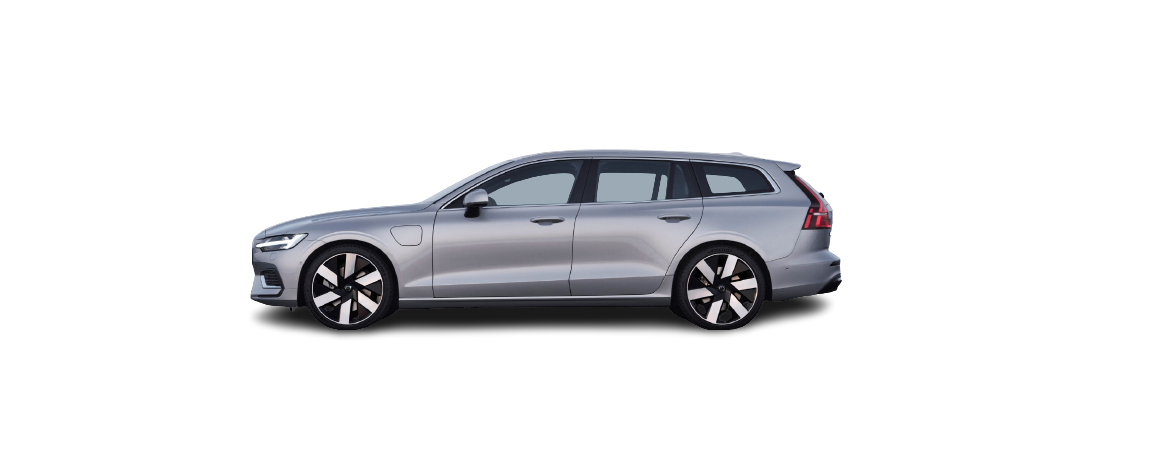2023 Volvo S60 Recharge Plug-in Hybrid Battery

Replacing the battery in the key
All batteries have a limited service life and must eventually be replaced (does not apply to Key Tag). The service life of the battery varies depending on how often the vehicle/key is used.
 The key’s battery needs to be replaced when the information symbol is illuminated and the The car key battery is low. See Owner’s Manual for replacement. message is shown in the driver display.
The key’s battery needs to be replaced when the information symbol is illuminated and the The car key battery is low. See Owner’s Manual for replacement. message is shown in the driver display.Another sign that the battery level is low is decreased range for the key.
The battery in the Key tag (Key Tag) cannot be replaced. When the battery is discharged, a new Key tag can be ordered from an authorised Volvo workshop.
Opening the key and changing its battery
ImportantAvoid touching the contact surfaces of a new battery with your fingers. This impairs the battery’s functionality.
Hold the key so that its front with the Volvo logotype is facing up, and with the keyring bracket facing you.
There is a catch on the left of the keyring bracket. If it is on the wrong side then the front and rear have been mixed up when the battery was replaced on an earlier occasion.
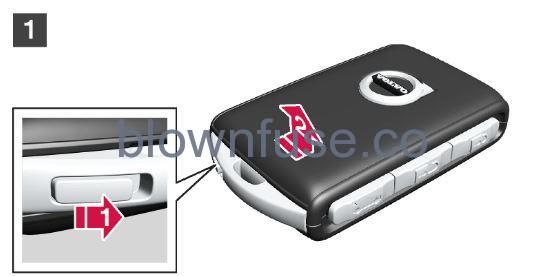
Slide the catch by the keyring bracket to the side, and slide the front shell away from the bracket.
- The shell detaches and can be lifted off.
- There is a further catch under the shell to detach the rear.

Slide the catch that was behind the front shell to the side, and slide the rear shell away from the key ring bracket.
- The shell detaches and can be lifted off.
- The battery cover is under the shell.
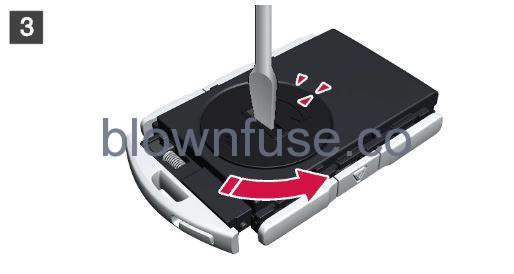
Turn the battery cover anticlockwise to OPEN position. Use a screwdriver or a coin, for example.
Lift off the battery cover. If it is difficult to detach, you can prize it upward using a narrow tool.

The battery (+) side is facing upwards. Loosen the battery by pressing on its edge and then lifting it out.

Install a new battery with the (+) side up. Avoid touching the key’s battery contacts with your fingers.
Position the edge of the battery under the two outer plastic catches.
Then press down on the battery so that it is held in place by the upper plastic catch.
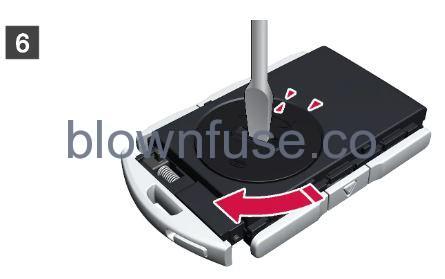
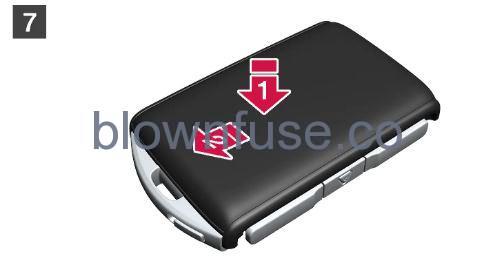
Refit the rear shell in reverse order to how it was removed. There is no logotype on the rear shell. Press in the shell until you hear a click, and then slide it the last few millimetres to its original position.
A further click will indicate that the shell is properly positioned and securely attached.
There must be no gaps remaining.
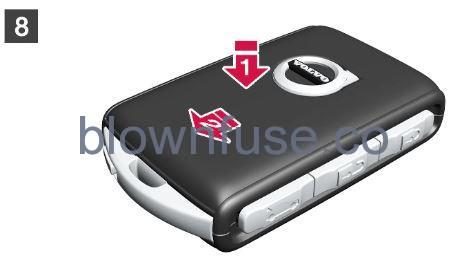
Turn the key and refit the front shell in the same way as for the rear.
Check that the battery is fitted correctly with the correct polarity. If the key shall not been used for a long time, remove the battery to avoid battery leakage and damage. Batteries with damage or leaks may cause corrosive injury on contact with the skin. Therefore, use protective gloves when handling damaged batteries.
- Keep batteries out of the reach of children.
- Do not leave batteries lying around since they can be swallowed by children or pets.
- Batteries must not: be dismantled, short-circuited or thrown into open flames.
- Do not try to charge non-rechargeable batteries. They may explode.
- Check battery operated products for signs of damage on a regular basis.
The key should not be used if anything indicates that the key or its battery has been damaged or has started to leak. Keep defective products out of the reach of children.
ImportantUsed batteries must be recycled in an environmentally sound manner.
Overloading the starter battery
There are several measures that reduce power consumption. Avoid using the ignition position II when the car is switched off. Instead, use ignition position I – which consumes less power. Do not use functions which use a lot of power when the car is not being driven. Examples of such functions are:
- ventilation fan
- headlamps
- windscreen wiper
- audio system
- accessories that are activated in the car.
If the battery level is low, a message is shown in the driver display. The energy-saving function then shuts down certain functions or reduces certain functions such as the ventilation fan and audio system.
In which case, charge the starter battery by starting the car and then running it for at least 15 minutes. Starter battery charging is more effective during driving than running at idling speed.
If the battery level continues to be low after the measures have been taken, the car should be checked at a workshop – an authorized Volvo workshop is recommended.
Using jump starting with another battery
Jump starting requires access to another car’s 12 V battery as well as jump leads.
Important
- The charging points in mild hybrid-type cars are designed for only jump-starting the car itself. Do not use the charging points of mild hybrids to start other cars – the fuse for the charging circuit may be overloaded so that it stops working.
- In mild hybrid-type cars, a discharged starter battery may be caused by an overloaded fuse that prevents charging. If the fuse has blown, the message 12 V battery fuse failure Service required is shown in
- the driver display. Volvo recommends that an authorized Volvo workshop is contacted.
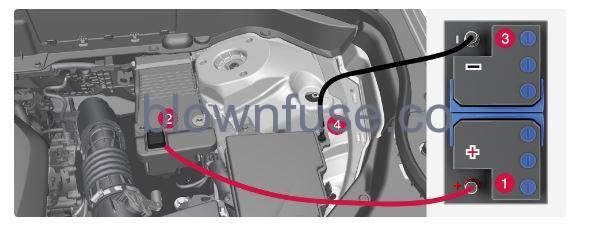
- Charging points for jump-starting own car. The appearance in the engine compartment may vary depending on car model and equipment level.
- When jump-starting the car, the following steps are recommended to avoid short circuits or other damage:
- Set the car’s electrical system in ignition position 0.
- Check that the donor battery has a voltage of 12 V.
- If the battery is installed in another car – switch off its engine and make sure that the cars do not touch each other.
- Connect one of the red jump lead clamps to the donor battery’s positive terminal (1).
Important
- Connect the jump lead carefully to avoid a short circuit and contact with other components in the engine compartment.
- Open the positive charging point’s cover (2).
- Attach the red jump lead’s other clamp onto the car’s positive charging point (2).
- Connect one of the black jump lead’s clamps to the donor battery’s negative terminal (3).
- Attach the black jump lead’s other clamp onto the car’s negative charging point (4).
- Check that the jump lead clamps are affixed securely. Poor contact may cause sparks or the clamps to loosen during the starting attempt.
- Start the engine of the donor car and allow it to run for a few minutes at a rotation speed higher than normal idle approx. 1500 rpm.
- Start the engine in the car with the discharged battery.
Remove the jump leads in reverse order – first the black and then the red.
Make sure that neither of the black jump lead’s clamps comes into contact with the car’s positive charging point, the donor battery’s positive terminal, or the clamp connected to the red jump lead.
Mild hybrid-type cars have components that work with 48 V voltage, which can be dangerous in the event of incorrect intervention. Do not touch components that are not clearly described in the owner’s manual.
- 48 V support battery must never be used for jump-starting.
- External electrical equipment must not, under any circumstances, be connected to the 48 V battery.
- The 48 V battery may only be serviced and replaced by a workshop – an authorized Volvo workshop is recommended.
Warning
- The battery can generate oxyhydrogen gas, which is highly explosive. A spark can be formed if a jump lead is connected incorrectly, and this can be enough for the battery to explode.
- Do not connect the jump leads to any fuel system component or any moving part. Be careful of hot engine parts.
- The battery contains sulphuric acid, which can cause serious burns.
- If sulphuric acid comes into contact with eyes, skin or clothing, flush with large quantities of water. If acid splashes into the eyes – seek medical attention immediately.
- Never smoke near the battery.
If the car has been jump-started, or if there is insufficient time to charge the battery using a battery charger, the Start/stop function will be temporarily deactivated until the battery has been sufficiently recharged by the car. In an outside temperature of approx. +15 °C (approx. 60 °F), the battery needs to be charged for at least 1 hour by the car. In a lower outside temperature, the charging time may increase to 3–4 hours. The recommendation is to charge the battery if possible using an external battery charger.
Batteries and power supply
The car’s primary electrical system operates with 12 V voltage and powers electrical equipment.
Batteries
In order to supply power to the various components, your car is equipped with the following:
- a 12 V starter battery that powers the car’s primary electrical system
- a support battery that helps during the Start/Stop function’s starting sequence. The battery is either a 12 V battery or, if the car is the mild hybrid type, a 48 V battery that also allows regenerative braking while driving.
Mild hybrid type cars have components that work with 48 V voltage, which can be dangerous in the event of incorrect intervention. Do not touch components that are not clearly described in the owner’s manual.
- 48 V support battery must never be used for jump starting.
- External electrical equipment must not, under any circumstances, be connected to the 48 V battery.
- The 48 V battery may only be serviced and replaced by a workshop – an authorised Volvo workshop is recommended.
Recycling the batteries
Symbols on the batteries
| |
Use protective goggles. |
| Further information in the owner’s manual for the car. | |
| Store the battery out of the reach of children. | |
| The battery contains corrosive acid. | |
| Avoid sparks and naked flames. | |
| Risk of explosion. | |
| Must be taken for recycling. |
Starter battery
- Never disconnect the starter battery when the engine is running.
- Check that the cables to the starter battery are correctly connected and properly tightened.
Warning
- The battery can generate oxyhydrogen gas, which is highly explosive. A spark can be formed if a jump lead is connected incorrectly, and this can be enough for the battery to explode.
- Do not connect the jump leads to any fuel system component or any moving part. Be careful of hot engine parts.
- The battery contains sulphuric acid, which can cause serious burns.
- If sulphuric acid comes into contact with eyes, skin or clothing, flush with large quantities of water. If acid splashes into the eyes – seek medical attention immediately.
- Never smoke near the battery.
The service life and capacity of the starter battery
The service life of the starter battery is influenced by a number of factors, such as the number of starts, discharges, driving style, driving conditions, and climate conditions. The battery’s starting capacity gradually decreases over time. Extreme cold further limits starting capacity.
The battery level may become low if the car if the car is not used for any length of time or if it only travels short distances.
To keep the starter battery in good condition, at least 15 minutes of driving a week is recommended, or connecting the battery to a battery charger with automatic trickle charging. A starter battery that is kept fully charged has a maximum service life.
Location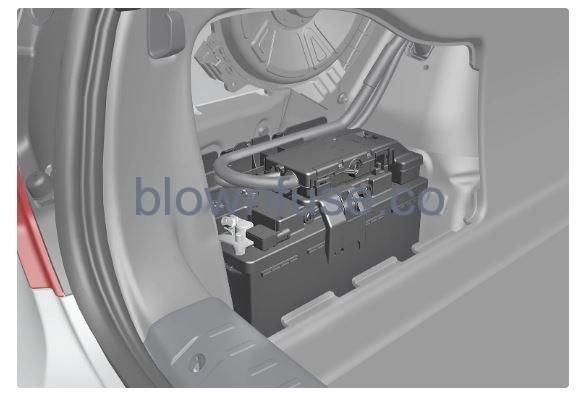
The starter battery is located in the cargo area.
Specifications for starter battery
| Battery type | H7 AGM | H8 AGM |
|---|---|---|
| Voltage (V) | 12 | 12 |
| Cold start capacity – CCA (A) | 800 | 850 |
| Size, L×B×H | 315×175×190 mm (12.4×6.9×7.5 inches) | 353×175×190 mm (13.9×6.9×7.5 inches) |
| Capacity (Ah) | 80 | 95 |
Support battery
Location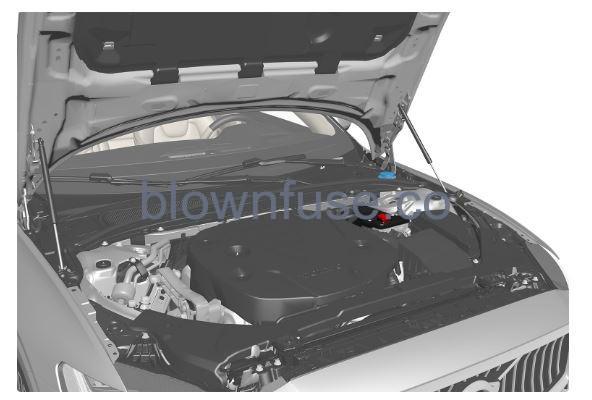
12 V support battery is located in the engine compartment.
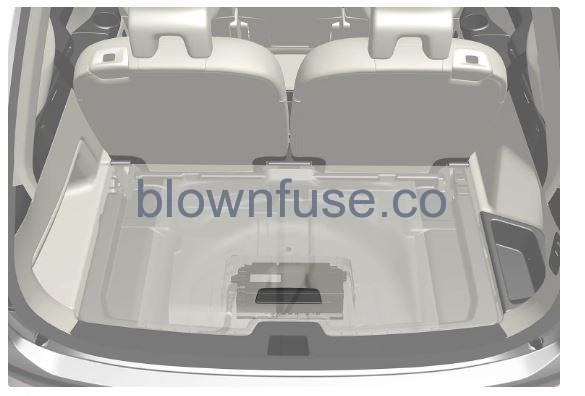
Cars of the mild hybrid type have a 48 V support battery located under the cargo area. The battery and the box around it must only be handled by an authorised workshop.
Support battery maintenance
The support battery normally requires no more service than the normal starter battery. A workshop should be contacted in the event of questions or problems – an authorised Volvo workshop is recommended.
Mild hybrid type cars have components that work with 48 V voltage, which can be dangerous in the event of incorrect intervention. Do not touch components that are not clearly described in the owner’s manual.
- 48 V support battery must never be used for jump starting.
- External electrical equipment must not, under any circumstances, be connected to the 48 V battery.
- The 48 V battery may only be serviced and replaced by a workshop – an authorised Volvo workshop is recommended.
Specifications for support battery
| Battery type | AGM |
|---|---|
| Voltage (V) | 12 |
| Cold start capacity – CCA (A) | 170 |
| Size, L×B×H | 150×90×130 mm (5.9×3.5×5.1 inches) |
| Capacity (Ah) | 10 |
If the car is the mild hybrid type, the support battery is a lithium-ion type 48 V battery.
